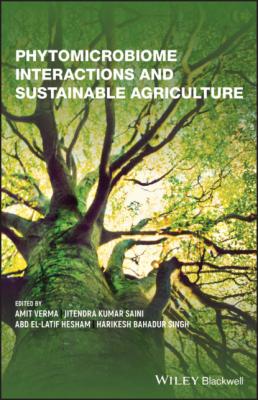Phytomicrobiome Interactions and Sustainable Agriculture. Группа авторов
Читать онлайн.| Название | Phytomicrobiome Interactions and Sustainable Agriculture |
|---|---|
| Автор произведения | Группа авторов |
| Жанр | Биология |
| Серия | |
| Издательство | Биология |
| Год выпуска | 0 |
| isbn | 9781119644828 |
Table 1.1 Root exudation of different plants: biochemical nature of root exudate components and techniques involved in characterization.
| Plant System | Exudate Profile | Technique | References |
|---|---|---|---|
| Maize (Zea mays) | Wide variety of fatty acids, nitrogenous compounds, organic acids, steroids, and terpenoid derivatives | GC–MS and 1H NMR | Lima et al. (2014) |
| Lettuce (Lactuca sativa) | Exudate comprises amino acids, amides, sugars, sugar alcohols, organic acids | GC–MS | Neumann et al. (2014) |
| Arabidopsis | Varied composition of sugars, sugar alcohols, amino acids and phenolics at different developmental stages | GC–MS | Chaparro et al. (2013) |
| Tall fescue (Lolium arundinaceum) | Sugars, polyols, growth factors and vitamins, lipids, amines, phenolics, carboxylic acids, nucleosides and others | GC‐(TOF) MS (gas chromatography –time of flight–mass spectrometry) | Guo et al. (2015) |
| Taro plants (Colocasia esculenta) | Organic acids like lactic acid, benzoic acid, m‐hydroxybenzoic acid, p‐hydroxybenzoic acid, vanillic acid, succinic acid and adipic acid. | GC–MS | Asao et al. (2003) |
| Potato (Solanum tuberosum L.) | Sugar quantification | Colorimetric estimation using glucose and fructose assay kits | Hoysted et al. (2018) |
| Maize (Zea mays) | Benzoxazinoids compounds | HPLC‐DAD | Neal et al. (2012) |
| Beech forest (Fagus sylvatica L.) | Low‐molecular organic acids | Ion chromatography | Shen et al. (1996) |
| Sugar Maple (Acer saccharum Marsh.) | Organic acids, carbohydrates, amino acids and amides | Thin‐layer chromatography | Smith (1970) |
| Betula alleghaniensis, Fagus grandifolia, and Acer saccharum | Carbohydrates, amino acids/amides, organic acids, and 9 inorganic ions | – | Smith (1976) |
| Fagopyrum esculentum | L‐tryptophan, fructose‐leucine or fructose‐isoleucine, fructose‐phenylalanine, N‐acetyl glutamic acid methyl ester | UHPLC‐HRMS | Gfeller et al. (2018) |
| Buckwheat (Fagopyrumesculentum) | Caprolactam, an inhibitory allelochemical | 1H and 13C NMR spectra | Tin et al. (2009) |
| Mesocosms having different plants | organic carbon | HPLC‐IRMS system | Karlowsky et al. (2018) |
| Datiscaglomerata | Flavonoids with abundant aglycones | HPLC, UV absorption and LC–MS | Gifford et al. (2018) |
| Medicago spp. | Flavonoids exclusively isoflavonoids | HPLC, UV absorption and LC–MS | Gifford et al. (2018) |
1.3 Role of Root Exudates in Shaping Rhizospheric Microbiomes
Root exudate composition resembles the plant constitution and its release of the organic compounds from the root zone allows it to participate in the rhizodeposition process (Jones and Darrah 1995). Root exudation is composed of a tremendous range of chemical compounds, including primary as well as secondary metabolites, ions, mucilage, reactive oxygen molecules, water molecules, amino acids, enzymes, peptides, sugars, vitamins, nucleotides, organic acids, plant inhibitors, growth regulators, sterols, fatty acids, phenolic compounds, flavonoids, and other miscellaneous chemicals (Bais et al. 2006; Huang et al. 2014; Tsuno et al. 2019). Root exudates contain the capacity to modulate the plant microbe interaction in the rhizosphere (De Weert et al. 2002; Zwetsloot et al. 2019). Moreover, these chemical compounds help microbes in the activity in the soil around the root, which is beneficial to plant development as well as to regain soil fertility.
Legume plants are considered an excellent example of shaping rhizospheric microbes through nitrogen assimilation through symbiotic associations of rhizobacteria. The key factor of plant rhizobia interaction in shaping rhizosphere is that flavonoid composition exists in the root exudates of legumes (Abdel Lateif et al. 2012; Weston and Mathesius 2013). Recently, researchers focused on microorganisms other than rhizobiums, which have the capacity of nitrogen fixation, such as cyanobacteria, Frankia, diazotrophsbacteria, etc. Several non‐leguminous plants have rhizobia for nitrogen fixation, such as in Parasponiasp. (family Cannabaceae), which may assist in the shaping of rhizospheric microbes.
Altering the behavioral changes in microorganisms through the effect of root exudates is proven and has been recently termed as “rhizosphere engineering”. In A. thaliana, root secretion possesses antimicrobial compounds that are responsible for its resistance to many non‐host pathogens that are present in the rhizosphere. Phenolic compounds and antimicrobial protein of root exudates may help in guarding the roots against potential pathogens (Bais et al. 2005). In experimental research, evidence shows that root exudate diversity is a crucial link between plant diversity and soil microorganisms (Steinauer et al. 2016). For better dynamic in‐depth interaction knowledge apart from phenolic compounds, flavonoid molecules and several biomolecules possess the capacity to increase favor around the rhizosphere. There are enormous biological molecules in root exudates, such as rosmarinic acid, jasmonic acid, and napthoquinones, which direct microbes toward plants for mutual benefit (Brigham et al. 1999;
